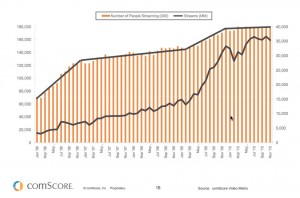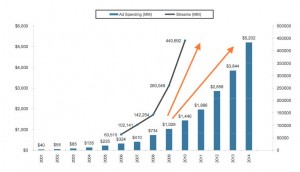comScore’s February data once again shows Google’s dominance in the online-video market, but Facebook is catching up. It’s now the fourth-largest online-video sharing property (see Facebook’s unofficial resource for more information). Facebook, as a sharp contrast from other sites, has short bursts of viewing (far shorter durations than other properties like YouTube, Hulu or Viacom (see BroadbandTV report).
comScore has a nice presentation that shows the “radical” growth of the medium (see download), and the total people relative to streams. It seems that the longer format of professional content (basically TV shows streamed online) is attracting a greater portion of advertising today.

To me, the most interesting part of this report is the acknowledgement that advertising dollars aren’t keeping up with the increase in online-video viewing. While this is probably true for the dawn of every preceding medium (radio, television, internet), it does suggest media buyers are in need of additional adjustments of the “media mix.” This requires better planning, and more creative built for the channel.

Because media-buying agencies (representing top brands) are more comfortable with television, it’s no surprise that Hulu is serving more ads per minute streamed. It’s familiar content and an easier format. Of course advertisers should be looking not just for “comfort” and targeting, but also “reduced clutter.”
Note that YouTube is not leader in advertising delivery (when you look at “ad views”). After Hulu, Tremor Media Video Network ranked second overall (and highest among video ad networks) with 503.7 million ad views, followed by ADAP.TV (432 million) and Microsoft sites (415 million).

2006-2010
Ad spend: +344%
Videos: +600%
Advertisers are struggling to catch up. Question is, once they will, how much more advertise will be force to watch?
Too many words and GRAPHS?? Im gonna have to duct tape my head to keep it from exploding. With openings at the nose and mouth for breathing purposes, all you asshats who’d love to imagine otherwise. Kudos to marlboro for the term asshat.
Hulu Forces Ads on every Video/page, while youtube only has ads on partner videos and channels and the main page. so what percentage of videos is that? That you have to consider into the mix
True, in fact YouTube is not the leader in this race so far (luckily), I’m afraid that be forced to watch an AD every time you see a cute puppy it simply won’t work. Premium content = pre-roll ad, at least I know what to expect before to watch, let’s say, a College Humor video. I guess with Hulu should work just fine considering the content. Fact is that every time a I watch a TV show on YouTube the AD at the beginning and in the middle of it are not really the best, slightly annoying I would say, although I can accept it because I’m watching a 25min TV show.
Hey Kevin, in your opinion, what’s the difference between a mainstream marketer and spammer trying to sell me CH34P V14Gr4? Essentially, both get paid to bombard me with stupid crap I have no desire for in a underhanded attempt at psychological manipulation. I’m not sure who I resent more deeply at the moment. The spammers at least probably realize they are scumbags and their work is easier to ignore as it isn’t nearly as ubiquitous (they stay nicely confined to my spam folder instead of cluttering my life with obnoxious billboards, unskippable DVD previews, infuriatingly repetitive pre-roll videos, and seizure inducing flashy pop-up ads screaming “YOU ARE A WINNER!!!”.)